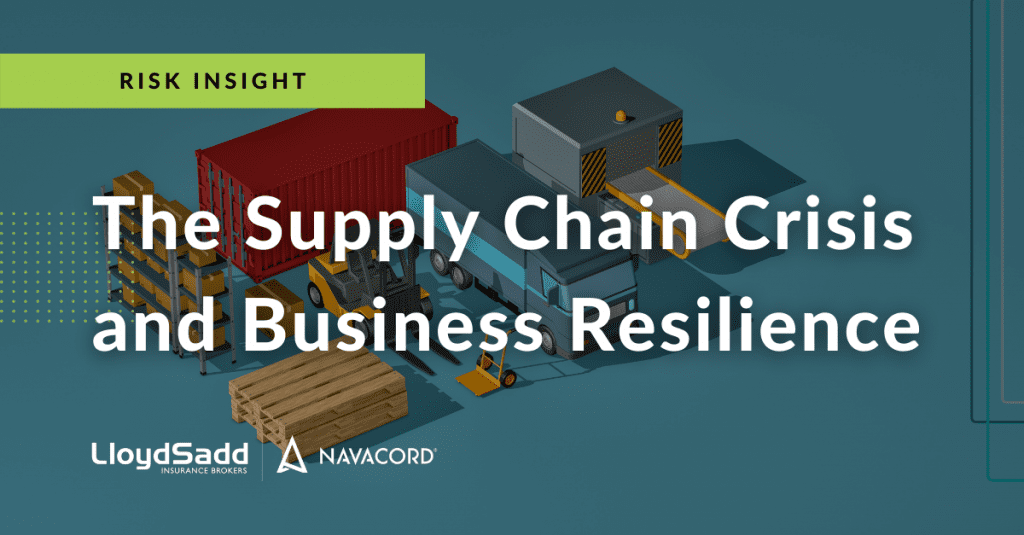The Supply Chain Crisis and Business Resilience

The COVID-19 pandemic spurred a supply chain crisis as businesses were forced to halt operations to slow the spread of the virus and prioritize employee health and safety measures. In addition, consumer demand is increasing, especially for automobiles, furniture, building equipment and appliances. As business operations begin to normalize, the exploding consumer demand is causing bottlenecks throughout the global supply chain.
This article discusses contributing factors to the supply chain crisis, how businesses can minimize vulnerabilities and the different types of insurance that could cover supply chain-related claims.
Factors Contributing to the Supply Chain Crisis
Since supply chains rely on people and equipment, delays and cost increases occur when there is a shortage of either. Supply chain disruptions not only create higher prices and scarcity among high-end consumer products, but they also affect basic commodities, such as generic drugs or energy, increasing the cost of living and the provision of basic needs. The following are some contributing factors of the supply chain crisis:
- COVID-19—There is a current supply and demand mismatch resulting from the COVID-19 pandemic. Supply chain problems arose as consumer demand increased and factories suspended production.
- Cyber risk—The COVID-19 pandemic forced companies to accelerate their digital transitions, resulting in more critical data being shared in far-reaching global supply chains. As cyberattacks increase in frequency and severity, they can cause operational, financial and reputational damages that cannot be recovered or repaired.
- Port backlog—Ocean-shipped goods are accumulating faster than workers can move them along, leading to backlogs and elevated shipping costs.
- Truck driver shortage—According to the Trucking HR Canada, there are an estimated 23,000 unfilled truck driving jobs. The driver shortage means that goods backlogged in ports and elsewhere can’t be moved.
- Natural disasters—Hurricanes, floods, blizzards and any natural disaster can disrupt global supply chains by postponing or pausing deliveries, closing ports and canceling cargo flights.
- Production issues—Factories closing and increasing technology demands have led to the global chip shortage. This has impacted auto, gaming, smartphone and medical device manufacturing as well as the production of any technology that requires semiconductors.
Business operations can become costlier, and stakeholder expectations for profit and sustainability may not be met during a supply chain crisis. Companies should put their energy and capital into short-term solutions that will make the most impact on their customers and stakeholders.
Minimizing Vulnerabilities
As supply chain industries continue to operate at reduced capacity, businesses can limit supply chain exposures by taking the following actions:
- Diversify supplier base. Using a single supplier can disrupt a business’s entire supply chain should an issue arise. Having a diverse supplier base disperses the risk and reduces risk impact.
- Have backup suppliers and vendors. There are several reasons a supplier may be unable to complete an order, including unprecedented demand or issues with their own supply chain. Identify suitable suppliers to use should problems occur with the primary supplier.
- Prepare a risk management plan. Identify and assess all current and potential risks that could disrupt business supply chains. Prepare procedures and responses for risks and build flexibility into business processes to adapt to disruptions.
- Aim for end-to-end supply chain visibility. Supply chains typically involve many operational stages, each with its own risks and challenges. Supply chain visibility can help mitigate risks by tracking progress and ensuring quick responses to any issues.
- Invest in cybersecurity. Some of the most common risks that affect supply chains include data leaks, breaches and malware attacks. Businesses should assess and improve current cybersecurity measures to mitigate supply chain risks.
- Purchase coverage. Specialty insurance policies can help businesses recover in the event of a supply chain crisis.
Insurance Solutions
Managing supply chain risks can be difficult since the risk factors tend to be complex. Consider transferring your risk by purchasing appropriate coverage, which could include the following depending on your exposure mix and risk tolerance:
- Coverage that accounts for business or income disruptions
- Marine and cargo coverage for long voyages taken by commodities, components and finished products
- Liability coverage, including commercial general liability and directors and officers liability
- Other special endorsements specific to your exposures
Carefully read your policy and ensure that it includes coverage of loss of supplier, stoppage of supply and interruption of service.
Conclusion
While there is no definitive timeline for when the supply chain crisis will end, estimates range from early 2022 to 2023. In the meantime, businesses should be proactive in identifying and preventing supply chain disruptions. For more information, contact us today.
To download the insight, click here: Risk Insight_Supply Chain Crisis and Business Resilience